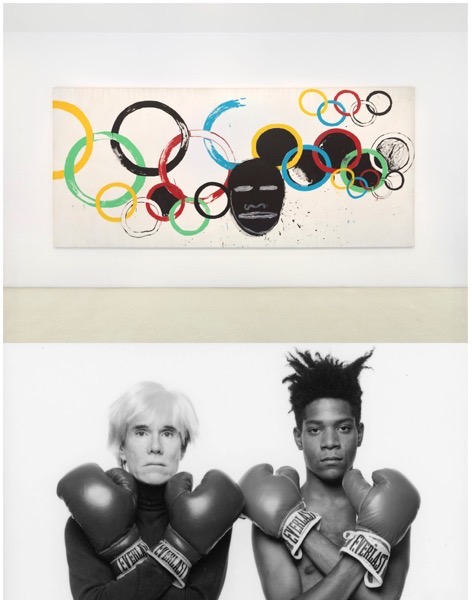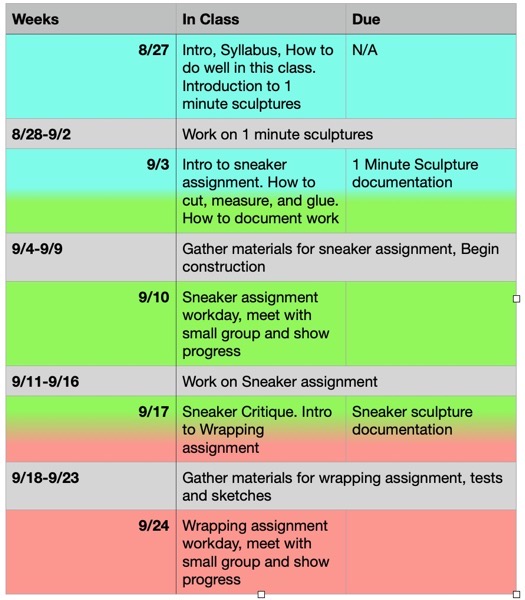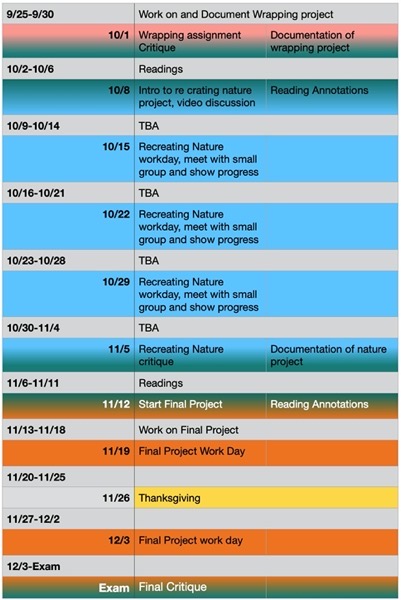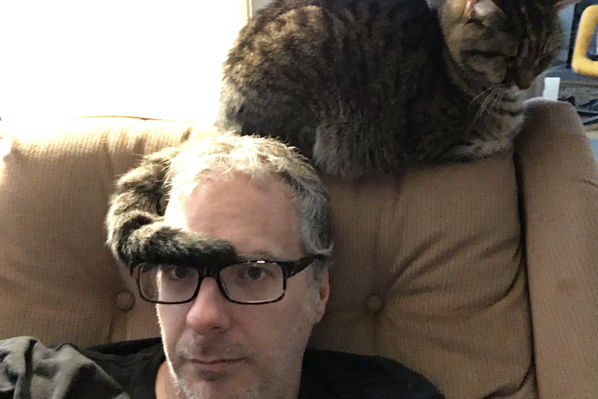Sculpture 1
Brian Davis
© Brian Davis
This is a syllabus, curriculum, course of study, program of study, educational program, course outline, timetable and schedule. It is whatever you need it to be. And there might be a test on it. If there is, the first answer will be “The Moops”
The information here (and more) can be found in the class Blackboard and at atimidmule.org. All dates are tentative and any changes can be found on the class calendar.
“I force myself to contradict myself in order to avoid conforming to my own taste.”
― Marcel Duchamp
Prologue
Sculpture I is a survey course that will introduce the
student to a range of contemporary sculptural techniques, materials and conceptual issues. The class will consist of a series of assignments/problems designed to address specific aspects of sculptural practice. Class time will include technical demos, lectures, discussions and time to work on projects.
Objectives:
- To learn to create meaning and function using space,
structure, material, surface and context.
- To gain hands-on experience with sculptural techniques and brains-on experience with three-dimensional problem-solving skills.
- To develop an understanding of the relevance and relationship of sculpture to all the areas of art study.
1 Introduction
Too full of adventure to be briefly described
How to do well in this class. In order to make it through the semester, and have a good time while doing it, you will need to do a few things.
Thing number one: read this document. This document is your contract for the semester. I’ve attempted to anticipate any questions and needs you might have throughout the semester. All those things I’ve attempted to anticipate are in this document.
Thing number two: get your supplies! Can’t make art without art making stuff. The supplies are essential for you to complete the projects and you need to get them at the beginning of the semester.
Thing number three: make space to work, both physical and mental. Since we are doing this online this semester, we don’t have the luxury of a dedicated studio space in the art building. Instead we need to make our own studio space. I realize that many of you will be working with limited space, but it is essential that you dedicate what space you can for just this activity. If you have to pull out your tools and work on your bed every time you need to work on a project, it will be that much harder to get started. Making space includes mental space, this means setting aside some distraction free time to focus on your project.
Thing number four: collaboration! You are going to be divided up into small groups for the semester. You can use these small groups for brainstorming, critiquing and emotional support, if you need that. The more you interact with your peers, the better you do in the class. Art is not made in a vacuum, contrary to romantic stereotypes. Art is almost always a collaborative effort in some way. So meet with, and get to know your group mates!
Thing number five: questions! Don’t be afraid to ask questions. Ask the teacher, your group mates, or others in the art department. You can ask questions at any time: during class, office hours, or via email. As this class is online, we don’t have the luxury of overhearing conversations in a group setting. Normally this goes a long way to help clear up projects and requirements. In order to counteract the lack of surreptitious audio, you must ask questions!
Thing number six: attend studio hours. We are trying something new this semester. As you know classes are only one day a week, so in order to allow for more interaction, we are having open virtual studio errors that can be attended by this class and others in the foundations area. You will be able to go into these virtual studio hours and be able to see what others are working on, and ask questions of the monitors, who will be other professors in the areas. Make use of this resource!
2 Collaboration and research
In which our hero has to wait the issue of an argument
This semester, we are going to try new platform to facilitate both collaboration and research. This platform is called Miro. Miro allows us to collaborate and edit on an infinite whiteboard. You can drag-and-drop images, embedded videos, leave notes, and draw links and diagrams around pertinent information.
Each group will have one Miro board for any group notes or resources that group wishes to make use of. When you are meeting with your group during breakout sessions, you can have this open to share images and ideas.
Each student will also have their own board for research. You use this board like a digital sketchbook. You can post pictures, articles, inspirational bits and bobs, or anything you need to collect that will help your ideation process during the semester. Remember research and sketching are a significant portion of each project grade. You should use this space to show me that work. We will discuss how to set this up in class.

3 Supplies
Accuracy! Accuracy!! Accuracy!!!
You are required to buy a standard materials and toolkit before the beginning of class. This kit contains most of the things you will need to complete the projects this semester. You can use the link provided to get almost the entire kit at Dick Blick, or you can source these items for yourself. Just make sure your items are equivalent to those on the list. I don’t course, if you already own these things you do not be to rebuy them.
Tools:
- X-Acto knife and blades
- Box cutter and blades
- Metal ruler
- Cutting mat
- Glue gun and glue sticks
- Spray Adhesive
- Tripod with phone attachment
Materials:
- Pack of 8.5 by 11 chipboard
Most of the supplies can be found with this wish list:
The tripod should be something like this.
Note: Certain projects will require you to collect other materials as needed.
“Dreams and reality are opposites. Action synthesizes them.”
― Assata Shakur, Assata: An Autobiography
4 Grades
In Which the Plot, Behaving in Much the Manner Of a Soup to which Corn Starch Has been Added, Begins, at Last, to Thicken
Grades function thusly:
There will be several projects, writings, group meetings and projects, and various activities throughout the semester. Each assignment is worth a certain number of points. At the end of the semester, your points are added up and your grade is averaged. Some projects are worth more points than others. Grades always includes preliminary sketches and models. Each assignment will be evaluated on the basis of the following criteria.
1. Fulfillment of the project objectives
2. Craftsmanship
3. Conceptual and material inventiveness
4. Physical investment: the sweat factor
5. Overall aesthetic and conceptual quality of the work
The overall breakdown of the final grade:
Projects-50%
Tests-30%
Writings/postings-20%
Grading:
A Work is characterized by outstanding achievement and understanding of critical analysis as reflected in solutions to assignments, technical competence and the critique process. Student must display preparedness and efficient dedication to scheduled studio time. Adherence to attendance policy.
B Work is characterized by excellent competence and understanding of critical analysis as reflected in solutions to assignments, technical competence and the critique process. Student must display preparedness and dedication to scheduled studio time. Adherence to attendance policy.
C Work is characterized by basic competence and understanding of critical analysis as reflected in solutions to assignments, technical competence and the critique process. Student must display adequate preparedness and dedication to scheduled studio time. Adherence to attendance policy.
D Work is characterized by minimal effort and success. Lowest passing grade.
5 Attendance
From which, remarkably enough, nothing develops
Attendance Policies: Students are expected to attend the synchronous classes of the courses for which they register. In-class participation is important not only to the individual student, but also to the class as a whole. Because class participation may be a factor in grading, instructors may use absence, tardiness, or early departure as de facto evidence of non participation. Students who miss an exam with an acceptable excuse may be penalized according to the individual instructor’s grading policy, as stated in the course syllabus
Attendance is mandatory.
2 unexcused absences = final grade reduced by 1 letter (A becomes a B),
3 unexcused absences = 2 letters
6 unexcused absences = failure no matter your grade
8 absences (excused or unexcused) will result in failure EVEN IF YOU HAVE A VALID REASON FOR YOUR ABSENCE.
Tardiness
If a student is more than 10 minutes late to class, this will count as a ½ absence (unexcused).
If a student is more than 25 minutes late to a class, they will not be permitted in the classroom, which will result in a full unexcused absence—unless they have given prior and timely notice and justification to the Instructor.
If a student leaves class 10 minutes or more early, this will result in a ½ absence (excused or unexcused).
“The reward for playing jazz is playing jazz.”
— John Lewis
6 Honorifics
Upright, spirited, and dangerous
Honor Code: Students in this class are bound by the Honor Code, as stated in the George Mason University Catalog. The honor code requires that the work you do as an individual be the product of your own individual synthesis or integration of ideas. (This does not prohibit collaborative work when it is approved by your instructor.) As a faculty member, I have an obligation to refer the names of students who may have violated the Honor Code to the Student Honor Council, which treats such cases very seriously. No grade is important enough to justify cheating, for which there are serious consequences that will follow you for the rest of your life. If you feel unusual pressure about your grade in this or any other course, please talk to me or to a member of the GMU Counseling Center staff.
Using someone else’s words or ideas without giving them credit is plagiarism, a very serious Honor Code offense. It is very important to understand how to prevent committing plagiarism when using material from a source. If you wish to quote verbatim, you must use the exact words and punctuation just as the passage appears in the original and must use quotation marks and page numbers in your citation. If you want to paraphrase or summarize ideas from a source, you must put the ideas into your own words, and you must cite the source, using the APA or MLA format. (For assistance with documentation, I recommend Diana Hacker, A Writer’s Reference.) The exception to this rule is information termed general knowledge—information that is widely known and stated in a number of sources. Determining what is general knowledge can be complicated, so the wise course is, “When in doubt, cite.”
Be especially careful when using the Internet for research. Not all Internet sources are equally reliable; some are just plain wrong. Also, since you can download text, it becomes very easy to inadvertently plagiarize. If you use an Internet source, you must cite the exact URL in your paper and include with it the last date that you successfully accessed the site.
Responsible Employee Disclosure: As a faculty member, I am designated as a “Responsible Employee,” and must report all disclosures of sexual assault, interpersonal violence, and stalking to Mason’s Title IX Coordinator per University Policy 1202. If you wish to speak with someone confidentially, please contact one of Mason’s confidential resources, such as Student Support and Advocacy Center (SSAC) at 703-380-1434 or Counseling and Psychological Services (CAPS) at 703-993-2380. You may also seek assistance from Mason’s Title IX Coordinator by calling 703-993-8730, or emailing titleix@gmu.edu.
Statement on Ethics in Teaching and Practicing Art and Design: As professionals responsible for the education of undergraduate and graduate art and design students, the faculty of the School of Art adheres to the ethical standards and practices incorporated in the professional Code of Ethics of our national accreditation organization, The National Association of Schools of Art and Design (NASAD).
Students with Disabilities and Learning Differences: If you have a diagnosed disability or learning difference and you need academic accommodations, please inform me at the beginning of the semester and contact the Disabilities Resource Center (SUB I room 234, 703-993-2474). You must provide me with a faculty contact sheet from that office outlining the accommodations needed for your disability or learning difference. All academic accommodations must be arranged in advance through the DRC.
“Everything is raw material. Everything is relevant. Everything is usable. Everything feeds into my creativity. But without proper preparation, I cannot see it, retain it, and use it.”
― Twyla Tharp
7 Resources
Digression in Praise of Digressions
Writing Center and Library Resources: Students who are in need of intensive help with grammar, structure or mechanics in their writing should make use of the services of Writing Center, located in Robinson A116 (703-993-1200). The services of the Writing Center are available by appointment, online and, occasionally, on a walk-in basis.
The Collaborative Learning Hub Located in Johnson Center 311 (703-993-3141), the lab offers in-person one-on-one support for the Adobe Creative Suite, Microsoft Office, Blackboard, and a variety of other software. Dual monitor PCs make the lab ideal for collaborating on group projects, Macs are also available; as well as a digital recording space, collaborative tables, and a SMART Board. Free workshops are also available (Adobe and Microsoft) through Training and Certification; visit ittraining.gmu.edu to see the schedule of workshops and to sign up.
Provisions Research Center for Art & Social Change is located in Room L001 of the Art & Design Building. This student resource assists students in exploring and engaging new models for art-making that lead to a more inclusive, equitable, and connected society. Provisions is also a hub for developing art projects through Mason Exhibitions, the Mural Brigade, and art partners throughout the metropolitan area, and beyond. Feel free to come in and browse the library, study, eat, etc. The University Art Librarian, Stephanie Grimm, will have regular hours in Provisions on Tuesdays at 2pm. Contact Don Russell for more information: drusse10@gmu.edu
Visual Voices Lecture Series: Visual Voices is a year-long series of lectures by artists, art historians and others about contemporary art and art practice. Visual Voices lectures are held on four Thursday evenings from 7:20- 9:00 p.m
September 10: D. Dominick Lombardi – “Resilience and Focus”
September 24: Steve Rost – “Channeling the Flâneur and other stories”
October 8: Augustina Woodgate – “Critical Circulation”
October 22: Adriana Ospina – “Working at the Art Museum of the Americas, Latin America and Diplomacy”
*For Fall 2020, this lecture series will be held online. http://art.gmu.edu/visualvoices/
“Art is the only way to run away without leaving home.”
― Twyla Tharp
8 Dates
I Begin Life On My Own Account, And Don’t Like It
Fall 2020 Schedule
First Day of Fall Classes: Payment Due Date Mon. Aug 24
Last Day to Submit Domicile Reclassification Application Mon. Aug 24
Last Day to Add: All Individual Sections Forms Due Mon. Aug 31
Labor Day: University Closed Mon. Sept 7
Last Day to Drop: With 100% Tuition Refund Tue. Sept 8
Drop period begins: 50% Tuition Refund Period Begins Wed. Sept 9
Final Drop Deadline: Last Day for 50% Tuition Refund Tue. Sept 15 (Final Drop)
Unrestricted Withdrawal Period: 100% Tuition Liability Wed. Sept 16 – Mon. Sept 28
Mid-term Evaluation Period: 100-200 level classes Mon. Sept 21 – Fri. Oct 16
Selective Withdrawal Period (Undergraduate students only) Tue. Sept 29 – Wed. Oct 28
Fall Break (classes do not meet) Mon. Oct 12
Monday Classes Meet (Tuesday classes do not meet this week) Tue. Oct 13
Incomplete Work from Spring/Summer 2020 Due to Instructor Sat. Dec. 5
Incomplete Grade Changes from Spring/Summer 2020 Due to Registrar Fri. Dec. 11
Thanksgiving Recess: No Classes (University Closed Nov. 26-29) Wed. Nov 25 – Sun. Nov 29
Dissertation/Thesis Deadline Fri. Dec 4
Reading Days Mon. Dec 7 -Tue. Dec 8
Examination Period Wed. Dec 9 -Wed. Dec 16
Winter Graduation Thu. Dec 17
Degree Conferral Date Sat. Dec 19
9 Schedule
In which we Begin Not to Understand


10 Of Importance
Digression in Praise of Digressions
This class fulfills a General Education Core requirement for Arts: This class fulfills a Mason Core requirement for Arts. Mason courses in the film making, visual and performing arts stress generative, inquiry based learning through direct aesthetic and creative experience in the studio environment. Art history courses address the intrinsic relationship of personal and cultural creativity, and the manifestation of aesthetics, visual culture and visual narrative within historical contexts.
Arts goal: Courses aim to achieve a majority of the following learning outcomes: students will be able to identify and analyze the formal elements of a particular art form using vocabulary appropriate to that form; demonstrate an understanding of the relationship between artistic technique and the expression of a work’s underlying concept; analyze cultural productions using standards appropriate to the form and cultural context; analyze and interpret material or
performance culture in its social, historical, and personal contexts; and engage in the artistic process, including conception, creation, and ongoing critical analysis.
University and School of Art Policies: In accordance with George Mason University policy, turn off all beepers, cellular telephones and other wireless communication devices at the start of class. The instructor of the class will keep his/her cell phone active to assure receipt of any Mason Alerts in a timely fashion; or in the event that the instructor does not have a cell phone, he/she will designate one student to keep a cell phone active to receive such alerts.
Commitment to Diversity: This class will be conducted as an intentionally inclusive community that celebrates diversity and welcomes the participation in the life of the university of faculty, staff and students who reflect the diversity of our plural society. All may feel free to speak and to be heard without fear that the content of the opinions they express will bias the evaluation of their academic performance or hinder their opportunities for participation in class activities. In turn, all are expected to be respectful of each other without regard to race, class, linguistic background, religion, political beliefs, gender identity, sex, sexual orientation, ethnicity, age, veteran’s status, or physical ability.
AVT 105 Course Expectations:
“We have an opportunity in this class to hear from people with different viewpoints and open some lines of communication about difficult or emotional topics. All opinions are welcome, as long as they are grounded in the evidence and presented respectfully. I reserve the right to manage, intercede, side-line, or stop a conversation if it is leading us too far off track or if it is disrespectful to others.
Preferred Pronouns: My name is Rachel Debuque and I use the pronouns she, her and hers. Pronouns are the parts of speech we use to refer to someone instead of their name. Using the right pronoun, like using someone’s correct name or title, is a way to show respect.”
Anti-Racist Statement: This class is committed to action toward addressing racial equities that persist within George Mason University. We must build intentional systems and standards of anti-racism that will keep racial injustices from regenerating. This includes curriculum, pedagogy, campus engagement, community engagement, policies, practices, research, and training and development.


About the Author
Brian Davis is a husband, father, sculptor, and multimedia artist who occasionally responds to student email at bdavis26@gmu.edu and can be found on Tuesday mornings holding his virtual office hours (check the calendar for the link.) He keeps some stuff at inadvisabledrain.com and atimidmule.org